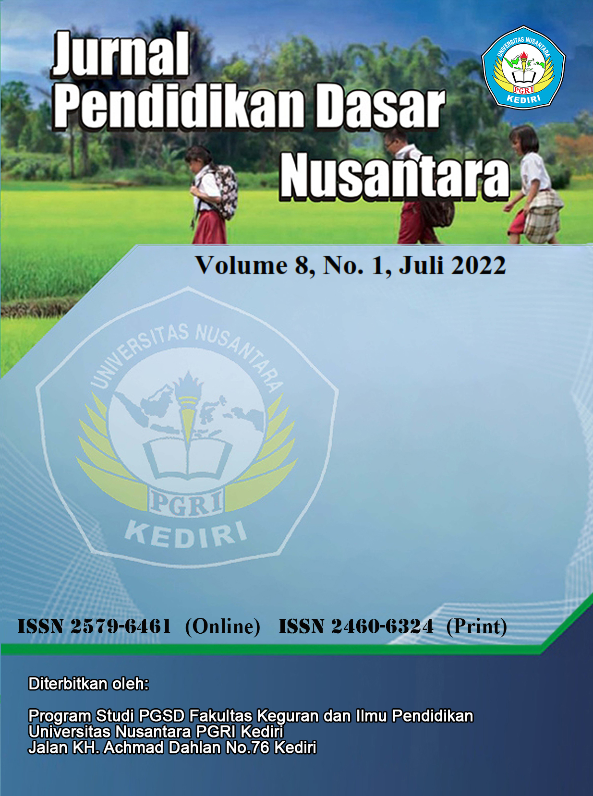THE INFLUENCE OF ACTIVE LEARNING STRATEGIES ON MATHEMATICS LEARNING MOTIVATION OF FIFTH GRADE STUDENTS OF ELEMENTARY SCHOOL (SD) NAKULA CLUSTER, JEMBRANA SUB-DISTRICT
DOI:
https://doi.org/10.29407/jpdn.v8i1.17845Keywords:
Motivasi belajar, Strategi pembelajaran aktif, Strategi pembelajaran konvensionalAbstract
This study aims to analyze the differences in learning motivation between students who study using active learning strategies and learning strategies. This type of research is a quasi-experimental (quasi-experimental) with a non-equivalent pretest-posttest control group design. The study population was all fifth graders at State Elementary School 2021/2022, totaling 162 people. The class sample was taken by random sampling technique. The sample consisted of 2 classes, namely Class V SDN 1 Banjar Tengah as many as 22 students who studied with active learning strategies and class V SDN 2 Banjar Tengah 22 students who studied with conventional learning strategies. The data collected in this study was data on students' mathematics learning motivation, which was obtained by using the mathematics learning motivation test, which had a reliability of 0.93. Mathematics learning motivation data were analyzed by descriptive analysis and one-way ANOVA. Hypothesis testing was carried out at a significance level of 5%. The results showed that there were differences in the motivation to learn mathematics between students who studied with active learning strategies and conventional learning strategies (F = 79.93; p <0.05). The results of the LSD test showed that students' motivation to learn mathematics using active learning strategies was higher than conventional learning strategies (LSD = 0.09) ; =0.42).
Downloads
References
Abdjul, T. 2013. Peningkatan motivasi belajar PGBI kelas Fisika Dasar II pada penyelenggaraan lesson study. Pendidikan dan Pembelajaran Sains, (Vol 8., No 1., hal 509-513). Tersedia pada http://ejurnal.ung.ac.id/index.php/JE/article/view/1159.
Ayu, P.L.N. & Sri, A.D.M. 2021. Pengaruh Implementasi Problem Based Learning Terhadap Motivasi Berprestasi dan Kemampuan Berpikir Kritis Pada Pembelajaran Tematik Terpadu Kelas IV SD Gugus IV Kecamatan Mendoyo. Jurnal Pendidikan Dasar Nusantara. (Vol 6, No 2, hal 52-70) [Makalah Online]. Tersedia pada https://ojs.unpkediri.ac.id/index.php/pgsd/article/view/14669
Chaudhari, A. 2013. Study habits of higher secondary school students in relation of their academic achievement. International Journal of Research in Humanities and Socual Sciences, ( Vol 1., No 3.,hal 52-14). Tersedia pada http://raijmr.com/wp.../11_52-54-Arvind-Chaudhari.pdf.
Gleason, B. L. Peeters, M. J. Resman-Targoff, B. H. Karr, S. McBane, S. Kelley, K. Thomas, T. & Denetclaw, T. H. 2012. An Active-learning strategies primer of achieving ability-based educational autcomes. American Journal of Pharmaceutical Educationd. (Vol 75., No 9., hal 1-12). Tersedia pada http://www.ncbi.nlm.nih.gov/pubm/22171114.
Mahmood, M. A. Tariq, M. & Javel, S. 2012. Strategies of active learning: an alternative to passive learning. Academic Research International. (Vol 1., No 3., hal 193-198). Tersedia pada http://www.savap.org.pk/journals/.pdf.
Putri, A. N. 2014. Penerapan strategi pembelajaran aktif everyone is a teacher here pada pembelajaran matematika siswa kelas VIII SMPN 3 Sungai Penuh. JEMS (Jurnal Edukasi Matematika dan Sains). (Vol 3, No 1, hal 1-8). Tersedia pada jurnal.umsb.ac.id/...Mar cellyna-Cendi-Harfama-09100 02842 02074.pdf
Utami, M. D. Mulyani, S & Ashadi. 2013. Studi komparasi pembelajaran aktif metode listening team dan metode guided note-taking dengan memperhatikan orientasi kepribadian siswa dalam bekerja sama kelas VIII SMPN 4 Surakarta tahun pelajaran 2011/2012. Jurnal Pendidikan Kimia, (Vol 2., No 1., hal 57-66). Tersedia pada http://jurnal.fkip.uns.ac.id/index.php/kimia/article/view/444
Sadirman, A. M. 2016. Interaksi dan motivasi belajar mengajar. Jakarta Raja Grafindo Persada.
Samadhi, A. 2018. Pembelajaran aktif. [Artikel Online]. Tersedia pada http://uripsantoso.files.wordpress.com/2011/06/active-learning_52.pdf.
Shahi, S. Hashemi, N. R. S. & Seltanzadeh, L. 2013. The effect of active learning on academic achievement motivation in high school students. Archives of Applied Science Research. (Vol 5., No 6., hal 127-131). Tersedia pada www.scholarsresearchlubrary.com.
Silberman, M. 2017. Active learning: 101 strategi pembelajaran aktif. Yogyakarta: YAPPENDIS.
Sri, A.D.M. Implementasi Pendekatan Saintifik Terhadap Prestasi Belajar IPA Ditinjau dari Minat Outdoor. Jurnal Ilmu Pendidikan, Keguruan, dan Pembelajaran. (Vol 3, No 2, Hal 76-83). Tersedia pada https://ojs.unm.ac.id/pembelajar/article/view/10398
Suastra, I W. 2019. Pembelajaran sains terkini: Mendekatkan siswa dengan lingkungan alamiah dan sosial budayanya. Singaraja: Universitas Pendidikan Ganesha.
Sugiyono. 2013. Metode Penelitian Pendidikan: Pendekatan kuantitatif kualitatif dan R&D. Bandung: Alfabeta.
Sugiyono. 2012. Metode Penelitian Pendidikan: Pendekatan kuantitatif kualitatif dan R&D. Bandung: Alfabeta.
Suryosubroto, B. 2012. Proses belajar mengajar di sekolah. Jakarta: Rineka Cipta.
Syah, M. 2015. Nilai-nilai pendidikan karakter dalam proses pembelajaran Matematika berbasis integrasi sains dan agama pada materi larutan penyangga kelas XI IPA SMA Islam Sultan Agung 1 Semarang. [Makalah Online]. Tersedia pada http://digilib.uinsby.ac.id/9645/3/bab1.pdf.
Tas, Y. & Cakir, B. 2014. An investigation of science active learning strategy use in relation to motivational beliefs. Mevlana International Journal of Education (MIJE). (Vol 4, No 1, hal 55-66). Tersedia pada http://dx.doi.org/10.13054/mije.13.55.4.1
Widiyanto, J. & Riyadi, S. 2017. Meningkatkan prestasi belajar ilmu pengetahuan alam melalui metode eksperimen pada kelas VIII B SMP Negeri 2 Jatipurno tahun pelajaran 2010/2011 (upaya pembelajaran aktif, inovatif, kreatif, efektif, menyenangkan). JEMS (Jurnal Edukasi Matematika dan Sains). (Vol 1., No 1., hal 1-7). Tersedia pada http://jurnalpendidikanprovisionwonogiri.blogspot.com/2012/03/jurnal-pendidikan-provision-vo11-no1.html.
Downloads
Published
Issue
Section
License
Authors who publish with this journal agree to the following terms:
- Copyright on any article is retained by the author(s).
- The author grants the journal, the right of first publication with the work simultaneously licensed under a Creative Commons Attribution License that allows others to share the work with an acknowledgment of the work’s authorship and initial publication in this journal.
- Authors are able to enter into separate, additional contractual arrangements for the non-exclusive distribution of the journal’s published version of the work (e.g., post it to an institutional repository or publish it in a book), with an acknowledgment of its initial publication in this journal.
- Authors are permitted and encouraged to post their work online (e.g., in institutional repositories or on their website) prior to and during the submission process, as it can lead to productive exchanges, as well as earlier and greater citation of published work.
- The article and any associated published material is distributed under the Creative Commons Attribution-ShareAlike 4.0 International License

































